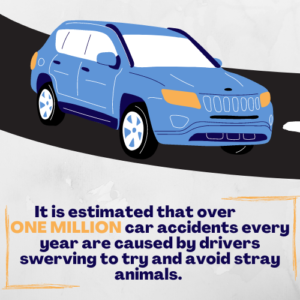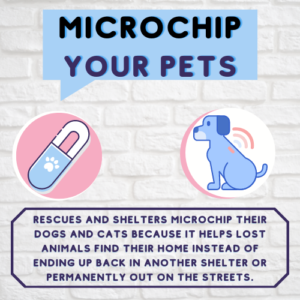Want to get involved and directly help pets in need? Check out our STEM to the Rescue Contest for elementary through high school ages!
Why Do Pets Need Our Help?
Pet ownership is on the rise in the United States of America, with more than 50% of the households having at least one pet. Despite that, more than 6,000,000 cats and dogs enter animal shelters in the United States each year. While many pets get to celebrate finding their forever home through the efforts of rescues organizations, there are over 900,000 cats and dogs each year that do not find homes and spend the final moments of their lives in the shelter.
Many orphan pets could avoid this fate with a bit more help from the people around them. There are various challenges that these animals face, as described below, but all of these hurdles can be overcome with the help of us all. Some obstacles may be larger than others, but each of us, no matter our age or abilities, can make a positive impact on the life around us.
Shelter Pet vs. Purebred Pet
When thinking about getting a new pet, many people have the misconception that shelter pets are there for a reason, whether because of their behavior or their medical status, and believe that purebred pets are of a higher quality. However, this is not the case at all. A study conducted out of US Davis in 2013 found that genetic diseases were more commonly found in purebred dogs, rather than dogs with mixed breeds. The reason these genetic diseases are more commonly found in purebred dogs is in their genes.
Genes carry the information your body needs to determine which traits are passed down to you from your parents. The problem arises when the genes passed down from both parents are too similar to one another. This is called inbreeding. Inbreeding happens when breeders select a specific animal with a desirable trait, and use that animal to either mother or father multiple litters. The result is a generation of animals that share very similar genes that they inherited by the shared parent. Over multiple generations, more and more animals share the same genes and the chances to develop a genetic disorder rise due to the lack of diversity in genetic material. A reputable pet breeder will do their best to avoid inbreeding, but it’s usually difficult for most people to tell a reputable breeder apart from an irresponsible breeder. Before you purchase a pet from a breeder, consider adopting a rescue pet! One of the most common reasons people look for a pet from a breeder rather than a rescue is because they are looking for a specific breed or purebred animal. However, you can find specific breeds in many rescue organizations.

These genes also play a part in some of the behavior traits you may see in some animals. Over time people bred for certain desirable characteristics, like pets with really long coats, or pets with a really good sense of smell, or pets that were more likely to cuddle with their owner. However, each animal is also an individual with their own preferences, ideas, and experiences that shape their personality, reactions, and overall behavior. Purebred pets are no more likely than mix-breed pets to have great personalities and behaviors.
While it is true that some pets in rescue situations may have come from bad situations that have taught them to be more nervous or fearful around people, many of these can be overcome by showing and teaching the animal that people are friends through consistent training, love, and understanding. Most rescues also work hard to pair the right pet with the right family, which is why they may ask a lot of questions when someone is trying to adopt a pet; they want to make sure the family and the pet will both be happy with each other for years to come.

It’s important for a family to select a pet that will match their lifestyle, regardless of the pet’s background. For example, some pets are naturally more energetic than others, so a family looking to get that type of pet needs to consider if they have the time to truly help that pet get all its energy out and be happy.
No matter what pet a family gets, some veterinary care and training will be needed to ensure the pet understands the rules of the new house so that they can behave as needed to keep everyone safe and happy. In fact, a bonus of adopting a pet from a rescue is they’ve received vet care prior to going home with someone, and the rescue will explain any next steps you need which makes it easy to understand.
Spaying and Neutering
 Spaying or neutering your pet is one of the best ways you can help prevent the overpopulation of dogs and cats. This is because spaying and neutering prevents dogs or cats from reproducing. Spaying and neutering is a common surgical procedure done by a veterinarian while the animal is under anesthesia. In addition to preventing more babies, spaying and neutering also provides physical and behavioral benefits for the animal.
Spaying or neutering your pet is one of the best ways you can help prevent the overpopulation of dogs and cats. This is because spaying and neutering prevents dogs or cats from reproducing. Spaying and neutering is a common surgical procedure done by a veterinarian while the animal is under anesthesia. In addition to preventing more babies, spaying and neutering also provides physical and behavioral benefits for the animal.
Many owners don’t think they need to spay and neuter because they don’t plan on breeding their pets, but many accidental babies can occur because of this. This could happen by mistake for a few reasons, such as if the pet gets out of their home, or if a stray pet comes into their yard, or when they’re visiting with another pet for a play date. Owners may think something like this would never happen to them, but it is one of the leading causes of pet overpopulation. Sometimes when a pet escapes because they are trying to find a mate, they might remain lost and end up as a stray, living on the streets which is dangerous for the animal and can contribute to more babies being produced that now have no home.
Sometimes the pets do return to the owner, but now that they have babies no one was planning on, the owners have to find homes for all those babies. Maybe the owners can find a few people to give some babies to, but one pet can produce a large litter, so many of the babies end up being given to a shelter, or become strays with no home. It is estimated that there are 35,000,000 stray cats in the United States. On average they have 1.4 litters a year and they average 3 kittens a litter. This means around 16,780 kittens an hour can be produced. Only 25% of those kittens survive past 6 months because they aren’t in a safe environment and don’t get the medical care and other resources they need to thrive.

Shelters can become overpopulated with dogs and cats due to many different factors, but a large one is due to lack of spaying and neutering. Other factors include animals being given away due to owners no longer wanting to or being able to care for health or behavior issues, or irresponsible pet owners that have too many animals or didn’t properly house their animals so they got out and became lost. It is estimated that 2.4 million healthy and adoptable dogs and cats are euthanized in the U.S. every year due to overpopulation. There are always more pets needing to come into the shelter and they only have so much room available.
One of the best ways we can ensure we don’t have overpopulated shelters or pets is to spay and neuter them. Nearly every shelter does this automatically with their pets, so when you adopt from an animal rescue, you know that your pet is already set!
Life as a Stray
 When there is an overpopulation of pets, unfortunately many of them end up living on the streets as strays. Stray pets pose a huge problem for people because they are uncared for and can carry harmful diseases or parasites that are spread to wildlife or people. Additionally, strays often run across roads or highways, unaware that there may be cars driving by. It is estimated that over 1 million car accidents every year are caused by drivers swerving to try and avoid stray animals.
When there is an overpopulation of pets, unfortunately many of them end up living on the streets as strays. Stray pets pose a huge problem for people because they are uncared for and can carry harmful diseases or parasites that are spread to wildlife or people. Additionally, strays often run across roads or highways, unaware that there may be cars driving by. It is estimated that over 1 million car accidents every year are caused by drivers swerving to try and avoid stray animals.
Stray pets often have shorter lifespans because living on the streets poses a lot of danger to them. They have to contend with wildlife including local predators. Since they don’t have guaranteed food or water, many of them are starving and dehydrated, and if they do find food it’s often not good for them to eat or might even be poisonous. Without shelter to protect them from the elements, they have to deal with weather and changing temperatures on their own. Unlike wild animals that are meant to live outside, stray pets are domesticated animals that are used to depending on people, especially if they were a pet who got out and got lost or got purposefully left behind by their owner. Because they don’t know how to take care of themselves, they’re often scared, unhealthy, and struggling to survive.

One way to help reduce the number of stray pets is to ensure that pets that are lost reconnect with the owners who are looking for them faster. The best way to do this is ensure your pet is microchipped. A pet microchip is a form of permanent identification, with a number unique to the pet it’s registered with, but the owner’s information can be updated as needed through an online portal in the event of phone number or address changes. The microchip doesn’t have GPS; it is a radio-frequency identification technology that can be scanned for information. The microchip is injected between the pet’s shoulders and takes only a few seconds. Most veterinarians and rescue facilities have microchip scanners in the event a lost pet is brought in. It is estimated that 10 million dogs and cats get lost in the United States every year and unfortunately only approximately 100,000 cats and 700,000 dogs get returned to their owners, so the majority of those pets never find their original homes.
Many owners feel that they will never need to microchip their pet because they feel confident their pet will never get lost. Unfortunately accidents happen and there is a particular increase in lost pets around holidays such as the 4th of July and New Year’s when loud noises cause pets to panic and look for a way to escape thinking they can get away from the noise.
A Pet is for Life
 Baby animals are too adorable to resist, right? However, before adopting one, understand that these babies always grow into adults that can live upwards of 15+ years depending on the breed. That means when adopting an animal, you must be ready to care for that animal for the entirety of its life. Cats and dogs are social animals meaning they can form relationships with people and have a variety of feelings. Rehoming a pet because of age or because you no longer want to take care of it can cause stress symptoms, which isn’t fair to the pet who doesn’t understand what is happening. Rehoming animals because you no longer want them also adds to the overpopulation of shelters, and might mean that pet never leaves the shelter for the rest of its life. When adopting, you must take into consideration increased vet bills as the animal gets older, changes to your lifestyle, and future housing arrangements. Will you be able to accommodate your new pet if your life changes?
Baby animals are too adorable to resist, right? However, before adopting one, understand that these babies always grow into adults that can live upwards of 15+ years depending on the breed. That means when adopting an animal, you must be ready to care for that animal for the entirety of its life. Cats and dogs are social animals meaning they can form relationships with people and have a variety of feelings. Rehoming a pet because of age or because you no longer want to take care of it can cause stress symptoms, which isn’t fair to the pet who doesn’t understand what is happening. Rehoming animals because you no longer want them also adds to the overpopulation of shelters, and might mean that pet never leaves the shelter for the rest of its life. When adopting, you must take into consideration increased vet bills as the animal gets older, changes to your lifestyle, and future housing arrangements. Will you be able to accommodate your new pet if your life changes?
If you’re not sure if you’re ready to adopt, many shelters can use the help of foster homes to support their intake of animals. This can be a way to get to know an animal before fully committing to their adoption. Fostering might mean getting very young animals or ones who need behavior help. It also comes with its own amount of responsibility to ensure the animal thrives under your care. Work with your shelter and double check that you’re able to meet all of their guidelines.
Educate others
 Even if you cannot help by adopting a homeless animal, you can also directly help support your local animal shelters by volunteering with them or organizing supply drives to fulfill wish list items they have. Everyone, no matter their age or abilities, can help by educating others. Many people are unaware of the challenges that orphan pets face or the misconceptions around some of the facts and most people are unaware there are steps we can all take to help! An easy way to educate others is to share the importance of spaying and neutering, microchipping, researching a pet before becoming their parent, and that adopting is an excellent option. Joining in with us on Remember Me Thursday is also a great way you can help spread this message far and wide. It’s a day to raise global awareness about our homeless pets and address their challenges, as well as celebrate their successes. This year, work to shine a light on orphan pets.
Even if you cannot help by adopting a homeless animal, you can also directly help support your local animal shelters by volunteering with them or organizing supply drives to fulfill wish list items they have. Everyone, no matter their age or abilities, can help by educating others. Many people are unaware of the challenges that orphan pets face or the misconceptions around some of the facts and most people are unaware there are steps we can all take to help! An easy way to educate others is to share the importance of spaying and neutering, microchipping, researching a pet before becoming their parent, and that adopting is an excellent option. Joining in with us on Remember Me Thursday is also a great way you can help spread this message far and wide. It’s a day to raise global awareness about our homeless pets and address their challenges, as well as celebrate their successes. This year, work to shine a light on orphan pets.
References
- (2018). U.S. pet ownership statistics. American Veterinary Medical Association. https://www.avma.org/resources-tools/reports-statistics/us-pet-ownership-statistics
- American Pet Products Association. (2021). Pet Industry Market Size & Ownership Statistics. American Pet Products Association. https://www.americanpetproducts.org/press_industrytrends.asp
- Pets by the numbers. (2021). HumanePro. https://humanepro.org/page/pets-by-the-numbers
- (2021). Pet Statistics. ASPCA. https://www.aspca.org/helping-people-pets/shelter-intake-and-surrender/pet-statistics
- Brulliard, K., & Clement, S. (2019, January 31). How many Americans have pets? An investigation of fuzzy statistics. The Washington Post. https://www.washingtonpost.com/science/2019/01/31/how-many-americans-have-pets-an-investigation-into-fuzzy-statistics/
- (2015, November 24). 10 Ways to Decrease the Number of Stray Animals. Central California SPCA, Fresno, CA. https://www.ccspca.com/animal-welfare/decrease-number-stray-animals/





